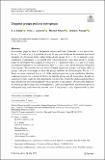Files in this item
Diagonal groups and arcs over groups
Item metadata
| dc.contributor.author | Bailey, R. A. | |
| dc.contributor.author | Cameron, Peter J. | |
| dc.contributor.author | Kinyon, Michael | |
| dc.contributor.author | Praeger, Cheryl | |
| dc.date.accessioned | 2021-07-14T12:30:05Z | |
| dc.date.available | 2021-07-14T12:30:05Z | |
| dc.date.issued | 2022-09-01 | |
| dc.identifier | 274753340 | |
| dc.identifier | 3aa888b2-fe91-40b4-90ed-29517bc3d837 | |
| dc.identifier | 000669393900001 | |
| dc.identifier | 85109298530 | |
| dc.identifier.citation | Bailey , R A , Cameron , P J , Kinyon , M & Praeger , C 2022 , ' Diagonal groups and arcs over groups ' , Designs, Codes and Cryptography , vol. 90 , no. 9 , pp. 2069-2080 . https://doi.org/10.1007/s10623-021-00907-2 | en |
| dc.identifier.issn | 0925-1022 | |
| dc.identifier.other | ORCID: /0000-0003-3130-9505/work/96817528 | |
| dc.identifier.other | ORCID: /0000-0002-8990-2099/work/96817531 | |
| dc.identifier.uri | https://hdl.handle.net/10023/23554 | |
| dc.description | Partially supported by Simons Foundation Collaboration Grant 359872 and by Fundacaopara a Ciencia e a Tecnologia (Portuguese Foundation for Science and Technology) grant PTDC/MAT-PUR/31174/2017. Australian Research Council Discovery Grant DP160102323. | en |
| dc.description.abstract | In an earlier paper by three of the present authors and Csaba Schneider, it was shown that, for m≥2, a set of m+1 partitions of a set Ω, any m of which are the minimal non-trivial elements of a Cartesian lattice, either form a Latin square (if m=2), or generate a join-semilattice of dimension m associated with a diagonal group over a base group G. In this paper we investigate what happens if we have m+r partitions with r≥2, any m of which are minimal elements of a Cartesian lattice. If m=2, this is just a set of mutually orthogonal Latin squares. We consider the case where all these squares are isotopic to Cayley tables of groups, and give an example to show the groups need not be all isomorphic. For m>2, things are more restricted. Any m+1 of the partitions generate a join-semilattice admitting a diagonal group over a group G. It may be that the groups are all isomorphic, though we cannot prove this. Under an extra hypothesis, we show that G must be abelian and must have three fixed-point-free automorphisms whose product is the identity. (We describe explicitly all abelian groups having such automorphisms.) Under this hypothesis, the structure gives an orthogonal array, and conversely in some cases. If the group is cyclic of prime order p, then the structure corresponds exactly to an arc of cardinality m+r in the (m−1)-dimensional projective space over the field with p elements, so all known results about arcs are applicable. More generally, arcs over a finite field of order q give examples where G is the elementary abelian group of order q. These examples can be lifted to non-elementary abelian groups using p-adic techniques. | |
| dc.format.extent | 11 | |
| dc.format.extent | 283719 | |
| dc.language.iso | eng | |
| dc.relation.ispartof | Designs, Codes and Cryptography | en |
| dc.subject | Diagonal group | en |
| dc.subject | Arc | en |
| dc.subject | Orthogonal array | en |
| dc.subject | Diagonal semilattice | en |
| dc.subject | Frobenius group | en |
| dc.subject | QA Mathematics | en |
| dc.subject | T-NDAS | en |
| dc.subject.lcc | QA | en |
| dc.title | Diagonal groups and arcs over groups | en |
| dc.type | Journal article | en |
| dc.contributor.institution | University of St Andrews. Centre for Interdisciplinary Research in Computational Algebra | en |
| dc.contributor.institution | University of St Andrews. Statistics | en |
| dc.contributor.institution | University of St Andrews. Pure Mathematics | en |
| dc.identifier.doi | https://doi.org/10.1007/s10623-021-00907-2 | |
| dc.description.status | Peer reviewed | en |
This item appears in the following Collection(s)
Items in the St Andrews Research Repository are protected by copyright, with all rights reserved, unless otherwise indicated.

